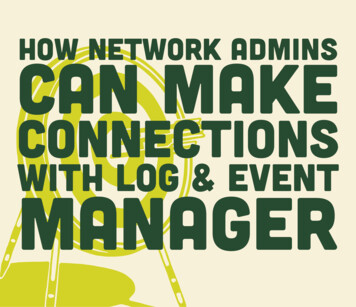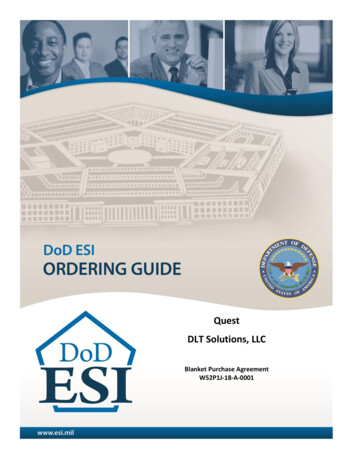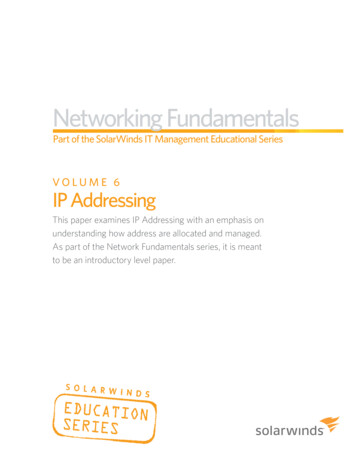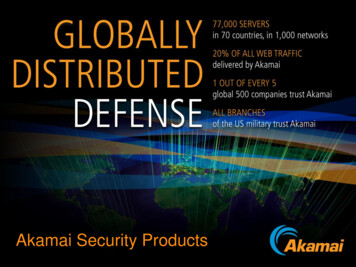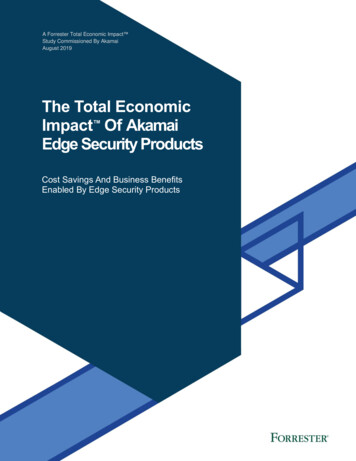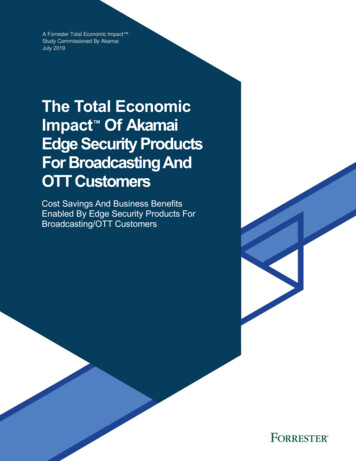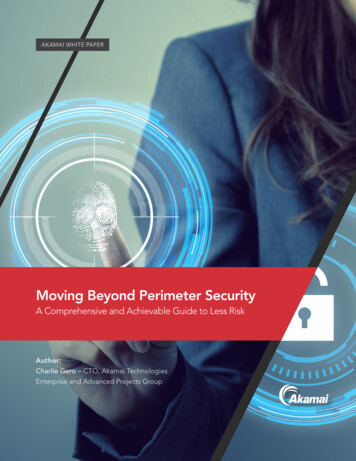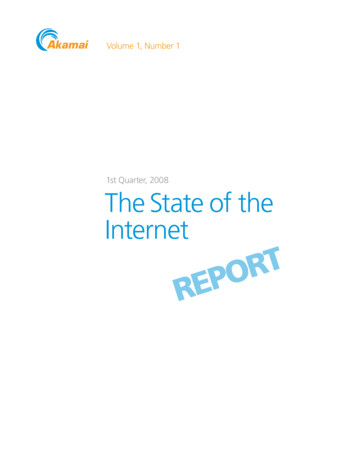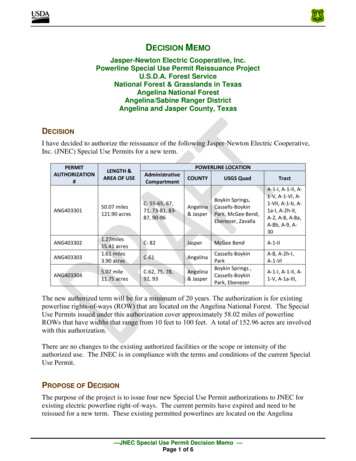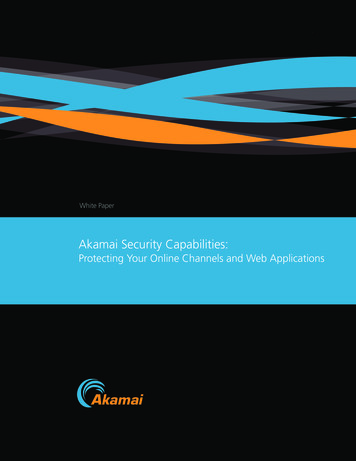
Transcription
White PaperAkamai Security Capabilities:Protecting Your Online Channels and Web Applications
Table of ContentsEXECUTIVE SUMMARY. . . . . . . . . . . . . . . . . . . . . . . . . . . . . . . . . . . . . . . . . . . . . . . . . . . . . . . . 1The Threat Landscape. . . . . . . . . . . . . . . . . . . . . . . . . . . . . . . . . . . . . . . . . . . . . . . . . . . . . 1Defense Beyond the Perimeter. . . . . . . . . . . . . . . . . . . . . . . . . . . . . . . . . . . . . . . . . . . . . . 2Akamai Security Capabilities . . . . . . . . . . . . . . . . . . . . . . . . . . . . . . . . . . . . . . . . . . . . . . . 3APPLICATION LAYER SECURITY . . . . . . . . . . . . . . . . . . . . . . . . . . . . . . . . . . . . . . . . . . . . . . . . . 4Web Application Firewall (WAF). . . . . . . . . . . . . . . . . . . . . . . . . . . . . . . . . . . . . . . . . . . . . 4HTTP Authorization Controls. . . . . . . . . . . . . . . . . . . . . . . . . . . . . . . . . . . . . . . . . . . . . . . 4User Prioritization. . . . . . . . . . . . . . . . . . . . . . . . . . . . . . . . . . . . . . . . . . . . . . . . . . . . . . . . 5NETWORK LAYER SECURITY. . . . . . . . . . . . . . . . . . . . . . . . . . . . . . . . . . . . . . . . . . . . . . . . . . . . 5SiteShield. . . . . . . . . . . . . . . . . . . . . . . . . . . . . . . . . . . . . . . . . . . . . . . . . . . . . . . . . . . . . . . 5Secure Delivery (SSL & Digital Certificates) . . . . . . . . . . . . . . . . . . . . . . . . . . . . . . . . . . . . 6PCI Compliance. . . . . . . . . . . . . . . . . . . . . . . . . . . . . . . . . . . . . . . . . . . . . . . . . . . . . . . . . . 6IP-Based Fraud Detection. . . . . . . . . . . . . . . . . . . . . . . . . . . . . . . . . . . . . . . . . . . . . . . . . . 6IP-Based Rights Management. . . . . . . . . . . . . . . . . . . . . . . . . . . . . . . . . . . . . . . . . . . . . . . 6IP Blacklisting/Whitelisting. . . . . . . . . . . . . . . . . . . . . . . . . . . . . . . . . . . . . . . . . . . . . . . . . 6DNS SECURITY. . . . . . . . . . . . . . . . . . . . . . . . . . . . . . . . . . . . . . . . . . . . . . . . . . . . . . . . . . . . . . . 7Enhanced DNS (EDNS) . . . . . . . . . . . . . . . . . . . . . . . . . . . . . . . . . . . . . . . . . . . . . . . . . . . . 7Global Traffic Management (GTM). . . . . . . . . . . . . . . . . . . . . . . . . . . . . . . . . . . . . . . . . . . 7DENIAL-OF-SERVICE MITIGATION. . . . . . . . . . . . . . . . . . . . . . . . . . . . . . . . . . . . . . . . . . . . . . . . 8The First Line of Defense: Massive Scale . . . . . . . . . . . . . . . . . . . . . . . . . . . . . . . . . . . . . . 8Traffic and Origin Health Monitoring . . . . . . . . . . . . . . . . . . . . . . . . . . . . . . . . . . . . . . . . . 8Additional DDoS Mitigation Capabilities . . . . . . . . . . . . . . . . . . . . . . . . . . . . . . . . . . . . . . 8BUSINESS CONTINUITY. . . . . . . . . . . . . . . . . . . . . . . . . . . . . . . . . . . . . . . . . . . . . . . . . . . . . . . . 9Zero-Downtime Delivery Platform . . . . . . . . . . . . . . . . . . . . . . . . . . . . . . . . . . . . . . . . . . . 9Improved Reliability for Dynamic Content . . . . . . . . . . . . . . . . . . . . . . . . . . . . . . . . . . . . 10NetStorage . . . . . . . . . . . . . . . . . . . . . . . . . . . . . . . . . . . . . . . . . . . . . . . . . . . . . . . . . . . . 10Site Failover. . . . . . . . . . . . . . . . . . . . . . . . . . . . . . . . . . . . . . . . . . . . . . . . . . . . . . . . . . . . 11EdgeComputing. . . . . . . . . . . . . . . . . . . . . . . . . . . . . . . . . . . . . . . . . . . . . . . . . . . . . . . . . 11AKAMAI: BUILDING A BETTER, MORE SECURE WEB. . . . . . . . . . . . . . . . . . . . . . . . . . . . . . . . 12
Akamai Security CapabilitiesExecutive SummaryAs companies continue to push their business-critical data and operations to the Internet,they must also take appropriate measures to protect these assets from the growing threatsof the online world. From worms and viruses, to phishing and pharming, to botnets anddenial-of-service attacks, the Internet’s open infrastructure is an easy target for criminalslooking to profit by stealing data, compromising systems, or otherwise disrupting theincreasing amounts of business transacted online. To combat this proliferation of threats,enterprises need a multi-layered defense architecture that can protect their increasinglyporous perimeter against potential attacks that are continually growing in sophisticationand magnitude.Situated at the entry point between end user requests and the enterprise’s core infrastructure,the Akamai EdgePlatform can uniquely provide certain critical layers within a robust defensesystem. Leveraging its vantage point as the world’s largest distributed computing platform,the EdgePlatform offers a broad range of flexible and highly scalable security capabilitiesto help customers extend their defenses out to the edges of the Internet and harden theirinfrastructure to the massive-scale attacks that are possible today.This whitepaper gives a broad overview of the ways in which Akamai can help organizationsbolster the security of their Web-based assets, with capabilities ranging across the application,network, and DNS layers, as well as solutions focused on Distributed Denial of Service (DDoS)mitigation and business continuity.IntroductionThe Threat LandscapeIn recent years, there has been a dramatic rise in the scale and severity of attacks launchedon Web sites and applications. Cyber crime has grown increasingly lucrative as companiesmigrate from mainframe to desktop to Web, relying more and more on the Internet formission-critical data and operations. The Internet is now a virtual gold mine of sensitivedata and valuable assets — but, unfortunately, its security stature has not yet caught up.In fact, the opposite is occurring: vulnerabilities have multiplied as the Web becomes anincreasingly complex and heterogeneous environment. Security plays second fiddle to thecompetitive pressures that drive unending cycles of rapid application development — so weaknesses and potential attack points are continually introduced. This means Web sites and applications are more susceptible to threats than ever. In fact, the Web Application Security Consortium recently found that more than 87% of Web applications carry a vulnerability classified ashigh risk or worse, with about half of the risks detectable through purely automated scanning.1To make matters worse, malware has grown increasingly dangerous, as worms and virusesleverage ever more sophisticated techniques and become more difficult to detect and counteract. With stealthy use of advanced rootkits, social engineering, encryption, polymorphism,and the like, malware is propagating faster than ever across millions of unsuspecting hosts.As a result, botnets — the armies of infected zombie machines that carry out many of today’scybercrimes — have grown exponentially in recent years. The Georgia Tech Information SecurityCenter estimates that as many as 34 million computers in the United States alone may nowbe part of a botnet. 2 Their numbers pose an enormous threat, because the zombie armies areboth cheap and highly effective at executing any number of different cyber crimes, includingDDoS attacks, data theft, spamming, phishing, and propagation of spyware and other malware.No one is safe: recent, well-publicized attacks have crippled all types of establishments, frompopular social networking sites to financial firms, from government organizations to the biggestnames on the Web. With these attacks proving financially lucrative, a highly sophisticated criminal underground has formed, complete with an active black market for specialized services andclear ties to organized crime. While they deliberately fly under-the-radar, their impact is veryreal: cyber crime is estimated to now cost businesses an estimated 1 trillion a year. 31
Akamai Security CapabilitiesDefense Beyond the PerimeterIn order to mitigate operational risks and secure missioncritical infrastructure in such a challenging threat environment,enterprises need to employ a defense-in-depth strategy, usingoverlapping layers of protection to detect and deflect attacksacross all tiers and access points of their infrastructure.In addition to traditional perimeter-based solutions such asfirewalls, intrusion detection systems, hardened routers, andother security appliances, a highly distributed, cloud-baseddefense system provides a necessary layer within the defensein-depth approach, particularly as enterprise network perimetersbecome more porous to accommodate a growing variety ofmobile devices, access methods, and client platforms.An edge-based defense offers unique capabilities for combatingthe pervasive, distributed nature of the Internet’s threats. Itcounteracts attacks at their source, rather than allowing themto reach the centralized perimeter. In addition, an edge architectureis the only one that can scale suffciently to absorb and deflect themassive-scale attacks that today’s botnets are capable of — including DDoS onslaughts that can barrage sites with traffic levelshundreds of times higher than usual.2Figure 1: Attack Traffic, Top Originating CountriesData from Akamai’s network shows that attack trafficsources continue to fluctuate, as the Internet’s global,interconnected nature makes cybercrime an equal-opportunity employer. These and other Internet statistics are published quarterly in Akamai’s State of the Internet reports.% TrafficQ1 09 %1 China2 United StatesCountry31.35%14.63%27.59%22.15%3 South Korea4 India5 Taiwan6.83%3.93%2.32%7.53%1.60%2.22%6 Brazil7 %1.79%2.95%30.75%–8 Mexico9 Japan10 Germany–OTHER79102863415Akamai Security CapabilitiesAkamai secures, monitors, and operates the Akamai EdgePlatform,the world’s largest, on-demand distributed computing network,with more than 50,000 servers across more than 1,000 networks,located in 70 countries around the world. With a proven trackrecord over a decade long, Akamai now delivers approximatelyone-fifth of all Web traffic and counts many of the world’s leadingenterprises as its customers, including: Three of the top five online brokerages Nine of the top 10 antivirus companies All the branches of the U.S. military Over 150 of the world’s leading news portals 85 of the top 100 online U.S. retailers, delivering over 100billion in e-commerce transactions annually through AkamaiDesigned with security, resilience, and fault-tolerance at theforefront, Akamai’s Edge-Platform is a proven platform forproviding flexible and intelligent edge-based defense capabilitiesat all layers of the OSI stack, as shown in Figure 2. Thesecloud-based capabilities help organizations lock downtheir security perimeter and bolster their defense-in-deptharchitecture with the highly flexible and scalable protectionsneeded to combat current day threats. Moreover, Akamai’sinnovative approach overcomes the traditional tradeoff ofsacrificing performance and availability for increased security.
Akamai Security Capabilities3Figure 2:Akamai’s proven EdgePlatform offers a broad range of highly scalable security capabilitiesthat combat cyber threats at the application layer, IP network layer, and DNS layer, andoffer DDoS mitigation and Business Continuity solutions across all tiers of infrastructure.HTTP Application LayerWeb Application FirewallHTTP Authorization ControlsUser PrioritizationDDOS ProtectionIP Network LayerBusiness ContinuityPlatform ScalabilityTraffic & Origin HealthMonitoringApplication, IP, and DNSlayer capabilitiesSiteShieldSecure Delivery (SSL& Certificate Services)PCI ComplianceIP-based Fraud DetectionIP-based Rights ManagementIP Backlists & WhitelistsZero-Downtime PlatformSureRoute TechnologySite FailoverNetStorageEdgeComputingDNS LayerEnhanced DNSGlobal Traffic ManagementApplication Layer SecurityMore and more cyber attacks are bypassing traditional firewall and email-specific securitycontrols by using increasingly sophisticated HTTP-layer attacks to target Web sites andapplications. Unfortunately, Web applications’ heterogeneous nature, combined withcontinual, rapid development cycles, often leaves many doors open to exploit. In fact, security firm Sophos estimates that in 2008, there was a Web page infected every 4.5 seconds. 4This trend drives the needs for firewalls and other security defenses that can understandand analyze Web traffic payloads such as HTTP, HTTPS, and XML — and provide protectionagainst treacherous application-layer threats such as cross-site scripting (XSS), buffer overflow exploits, and SQL injection attacks. Akamai delivers this type of protection at theedge of the network, augmenting traditional defense solutions with an unprecedentedlevel of built-in redundancy and scalability.Web Application Firewall (WAF)Akamai’s Web Application Firewall service is a highly scalable edge defense system withthe ability to detect potential attacks in HTTP and SSL traffic as it passes through theEdgePlatform, before reaching the customer’s origin data centers. The WAF service givescustomers the ability to set up traffic blocks or alerts based on rules that either check forthe presence of specific data like cookies, client certificates, and referrer fields, or detectanomalous and potentially malicious patterns in HTTP request headers. Based on a translation of the open source ModSecurity core rule set (CRS), Akamai WAF’s protects againstthe most common and harmful types of attacks, including XSS and SQL injection.
Akamai Security CapabilitiesWAF is unique in its highly distributed architecture, whichenables both instantaneous scaling of defenses as needed aswell as filtering of corrupt traffic as close to the attack sourceas possible. Moreover, unlike a centralized firewall, WAF doesnot create any performance chokepoints or single pointsof failure that often prove to be easy targets for attackers.Akamai’s Web Application Firewall uses configurable,rule-based application layer controls to prevent the followingtypes of attack vectors: Protocol Violations Request Limit Violations HTTP Policy Violations Malicious Robots Generic and Command Injection Attacks Trojans Backdoors Outbound Content Leakage (Server Banners)Not every type of Web application attack is best dealt withas it passes through Akamai’s infrastructure. Some classesof attacks may be better addressed using detailed knowledgeof the specific applications, databases and network infrastructure in the customer data center. Thus, WAF provides a highlyflexible and efficient outer defense layer that works bothas a stand-alone service and as a complement to other Webapplication protection systems — enhancing the robustnessand scalability of those systems by migrating some of theirfunctions to the Akamai platform so that centralized defensescan focus on more application-specific protections.HTTP Authorization ControlsAkamai offers various authorization mechanisms that allowcustomers to retain full control over proper distributionof their access-controlled content, while still enjoying theenhanced performance and scalability offered by the Akamainetwork. The customer designates which content requiresauthentication and what authorization mechanism to use.These mechanisms include: Centralized User Authentication. The protected contentresides on Akamai’s edge servers but each end user requestis authenticated by the customer origin server before delivery,enabling centralized control while taking advantage of thehigh performance of offloaded delivery.4 Edge User Authentication. Akamai’s edge serversauthenticate user requests for content on behalf of thecustomer origin server. This unique feature works basedon a combination of encrypted cookies and special contentURLs, dynamically generated by the customer origin server.The customer retains complete flexibility to choose the criteriawith which to grant or restrict access, but the authenticationand delivery process are completely offloaded to Akamai. Akamai Authentication. This is a flexible and robustmechanism to authenticate Akamai’s edge servers to thecustomer’s origin server using a shared secret key. This meansthe origin server can securely authenticate requests from anyserver in the Akamai network without using a preset list ofIPs or other more rigid mechanism.User PrioritizationAkamai offers the capability to manage flash crowd situationswhere the customer’s application server is at risk of failure. Bymonitoring application server health, Akamai is able to throttleload to the server when necessary, redirecting excess users toalternate, cached content — a virtual waiting room which keepsthem engaged on the site and keeps the origin server frombecoming overloaded. This offers a double benefit, as casestudies show that recovering traffic levels after a site failure(where the site is completely inaccessible) takes much longerthan recovering from a site slowdown.Network Layer SecurityWhile cyber attacks are growing in sophistication and anincreasing number of the most devastating attacks are focusedon the application layer, the IP layer still accounts for nearlytwo-thirds of attacks today. 5 Accordingly, defenses that hardenthis fundamental layer of Internet communications are essentialto the security of any Web infrastructure. Akamai leverages itsunique architecture and real-time Internet knowledge base tooffer a number of capabilities that help secure the network layer.SiteShieldAkamai’s SiteShield service helps protect the customer originserver by cloaking it from the public Internet — that is, removingit from the Internet-accessible IP address space. This mitigatesrisks associated with network-layer threats, including lower layerDDoS attacks that direct target the origin server.
Akamai Security CapabilitiesSiteShield works by allowing the customer’s firewall to restrict incoming connectionsto Akamai SiteShield servers only, rather than leaving the standard HTTP/S ports 80and 443 open and vulnerable to all incoming connections. SiteShield servers canbe configured to communicate with the origin on non-standard ports as well toprovide additional port masking protection. Akamai’s EdgePlatform intercepts andfulfills each end user request, on the customer’s behalf, communicating securely and“invisibly” with the origin server as necessary to retrieve content that is not in cache.Customer Case Study: SiteShield Akamai SiteShield protects U.S. Citizen and Immigration ServicesWhen the U.S. Citizen and Immigration Servers (USCIS) wanted to both streamlineits infrastructure a
forefront, Akamai’s Edge-Platform is a proven platform for providing flexible and intelligent edge-based defense capabilities at all layers of the OSI stack, as shown in Figure 2. These cloud-based capabilities help organizations lock down th
